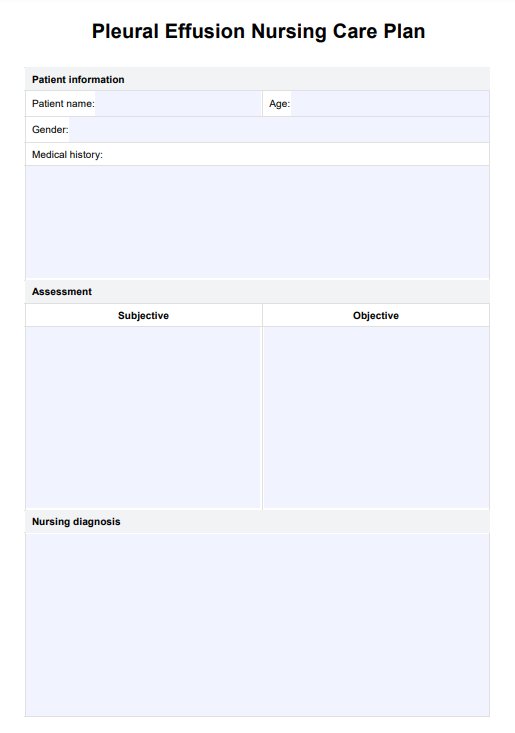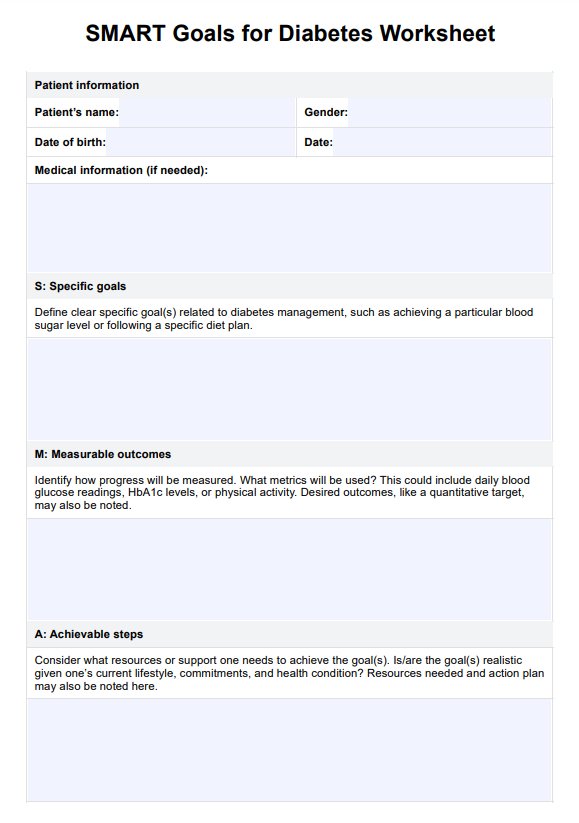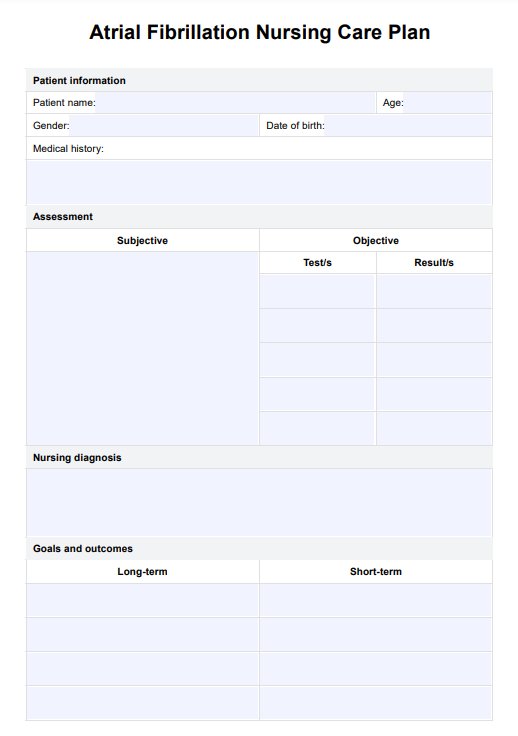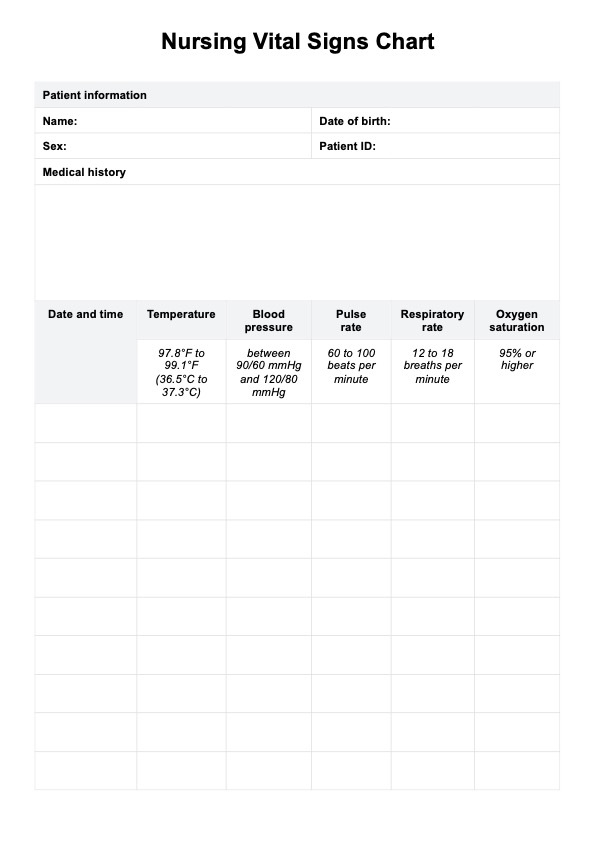Faces Pain Scale
Improve how you assess patient pain with our FACES Pain Scale template. Better understand their pain severity and improve how you plan pain management.


What is a FACES Pain Scale?
The FACES Pain Rating Scale, developed by Donna Wong and Connie Baker, is a well-known self-report measure that includes faces representing each level of pain. The FACES Pain Rating scale was originally developed to help in pediatric pain measurement (Wong-Baker FACES Foundation, 2009), as very young children are not usually able to identify and communicate the amount of pain that they are feeling. Using this free printable FACES pain scale, you can better identify and manage pain to reduce discomfort and work towards improved healthcare experiences.
This nonverbal assessment relies on facial expressions to assess pain. No prior knowledge or extensive instructions are required, meaning it is suitable for healthcare professionals to use for patients of various ages. They just need to look at the faces in the diagram.
The original Wong-Baker pain scale has six faces, each representing a pain score. This is the pain level that each of the faces indicates:
- 0 - No hurt
- 2 - Hurts a little bit
- 4 - Hurts a little more
- 6 - Hurts even more
- 8 - Hurts a whole lot
- 10 - Hurts worst
The FACES Pain Rating Scale helps providers assess pain for any individual, not just children. It is often an effective tool for people who either have difficulty understanding and communicating their pain level or those with developmental disabilities. Anyone who works with children or people with difficulties communicating their pain can use this scale, such as nurses, doctors, dentists, speech-language pathologists, emergency medical technicians (EMTs), and therapists.
The Wong-Baker Pain Scale is just one of multiple pain assessment scales available. Another similar numeric pain rating scale is Bieri and colleagues' Faces Pain Scale (Bieri et al., 1990), which was revisited by Hicks and colleagues in 2001 and improved into the Faces Pain Scale-Revised. This scale also helps providers assess pain intensity and improves patient communication as it uses facial expressions with associated pain scores. However, the original scale by Bieri and colleagues has 7 faces, scored from 0 to 6; Hicks and colleagues' revised scale reduced this to 6 faces, similar to the Wong-Baker scale.
Our free template contains the Wong-Baker scale, the similarly named scale by Bieri and colleagues, and Hicks and colleagues' revised scale, all of which have strong positive correlations with the Pain Visual Analogue Scale (Garra et al., 2010; Hicks et al., 2001).
Faces Pain Scale Template
Faces Pain Scale Example
How to use our FACES Pain Scale template
Our FACES Pain Scale template offers healthcare professionals a straightforward tool for assessing pain through visual cues. It includes three widely recognized scales—the Wong-Baker scale, Bieri et al.'s scale, and Hicks et al.'s revised scale—along with a pain tracker to monitor patient progress. Follow these steps to integrate it into your practice:
Step 1: Access the template
Click "Use template" to open it in the Carepatron app, where you can customize, share, fill it digitally, or print it. This feature allows for seamless collaboration and secure storage. Alternatively, click "Download" to save a fillable PDF version for printing or offline use.
Step 2: Assess the patient
Show the patient each scale and explain how the faces represent increasing pain levels. Encourage them to select the face that best matches their current pain level. For patients with cognitive impairment, guide them gently through the process to ensure accurate responses.
Step 3: Record and discuss results
Document the selected pain score and use the pain tracker to monitor any patterns or changes over time. Engage the patient in a discussion about the results, explaining how the pain score influences their care plan and encouraging them to actively participate in managing their pain.
When would you typically use a FACES Pain Scale?
The FACES Pain Scale is typically used when a patient needs to report their pain severity but may have difficulty expressing it verbally. This makes the scale ideal for pediatric patients, as young children may not fully understand how to describe their pain levels. It’s also beneficial for patients with cognitive impairment, developmental delays, or language barriers, as the visual nature of the scale allows them to point to the face that best represents their pain.
Additionally, the scale can be useful for patients with limited communication abilities, such as those recovering from stroke or suffering from conditions that affect their ability to articulate their feelings. By utilizing the FACES Pain Scale, healthcare professionals can better understand their patient's pain and tailor their treatment plans more effectively.
Why is this assessment popular with physical therapists?
The FACES Pain Scale is widely used among physical therapists due to several practical advantages:
- Visual representation: Patients can easily express their pain level by selecting a corresponding facial expression, making it accessible for those with limited communication abilities.
- Ease of use: The template can be quickly downloaded or accessed through the Carepatron app for in-person or remote consultations, ensuring convenience for both therapists and patients.
- Adaptability: It suits various patient populations, including children, adults with cognitive impairment, and individuals with communication challenges.
- Facilitates communication: The scale enhances patient-therapist communication, improving the therapist’s understanding of the patient’s pain experience.
- Widely recognized: The FACES Pain Scale is a validated, trusted tool within the medical community, allowing therapists to align with standard care practices.
These benefits make the FACES Pain Scale an effective tool for physical therapists, supporting tailored treatment planning and improved patient outcomes.
Evidence of effectiveness
The Wong-Baker FACES Pain Rating Scale has demonstrated strong validity, with high correlations to the Visual Analogue Scale (VAS). In a study by Garra et al. (2010), the correlation coefficient between the FACES Pain Scale and the VAS reached 0.90, supporting its reliability for assessing pain severity. This scale helps clinicians quantify subjective pain using a visual representation of facial expressions, facilitating more effective communication, particularly with pediatric patients or those with cognitive impairment.
However, while the Wong-Baker scale provides valuable insight into pain levels through facial expressions, its reliance on traditional pain scores limits its depth in pain management. Adeboye et al. (2021) noted that using the Functional Pain Scale (FPS) offers a more nuanced understanding of patient pain by considering factors beyond numerical ratings, such as the functional impact of pain on daily activities. This critique emphasizes that, although the FACES Pain Scale is effective, incorporating additional pain scales and assessments can enhance individualized care and treatment planning.
References
Adeboye, A., Hart, R., Senapathi, S. H., Ali, N., Holman, L., & Thomas, H. W. (2021). Assessment of Functional Pain Score by comparing to traditional pain scores. Cureus, 13(8). https://doi.org/10.7759/cureus.16847
Bieri, D., Reeve, R. A., Champion, D. G., Addicoat, L., & Ziegler, J. B. (1990). The Faces Pain Scale for the self-assessment of the severity of pain experienced by children: Development, initial validation, and preliminary investigation for ratio scale properties. Pain, 41(2), 139–150. https://doi.org/10.1016/0304-3959(90)90018-9
Garra, G., Singer, A. J., Taira, B. R., Chohan, J., Cardoz, H., Chisena, E., & Thode, H. C. (2010). Validation of the Wong-Baker FACES Pain Rating Scale in pediatric emergency department patients. Academic Emergency Medicine, 17(1), 50–54. https://doi.org/10.1111/j.1553-2712.2009.00620.x
Hicks, C. L., von Baeyer, C. L., Spafford, P. A., van Korlaar, I., & Goodenough, B. (2001). The Faces Pain Scale – Revised: Toward a common metric in pediatric pain measurement. Pain, 93(2), 173–183. https://doi.org/10.1016/s0304-3959(01)00314-1
Wong-Baker FACES Foundation. (2009). Wong-Baker FACES® history. https://wongbakerfaces.org/us/wong-baker-faces-history/
Commonly asked questions
The FACES Pain Scale helps patients, especially children and individuals with communication difficulties, express their pain severity using facial expressions. It provides healthcare professionals with a reliable and straightforward way to assess pain and plan effective pain management strategies.
The 0-5 face pain scale is associated with several versions, including the Wong-Baker FACES Pain Rating Scale and Hicks et al.'s revision of Bieri et al.'s original scale. The Wong-Baker scale scores pain at intervals of 0, 2, 4, 6, 8, and 10, while some versions, including Hicks et al.'s, simplify it to 0-5 to align with specific clinical needs.
The FACES Pain Scale is suitable for children as young as three years old and for individuals with communication barriers, such as cognitive impairments. It is a helpful tool for any patient struggling to express their pain verbally, including older adults or those with developmental disabilities.


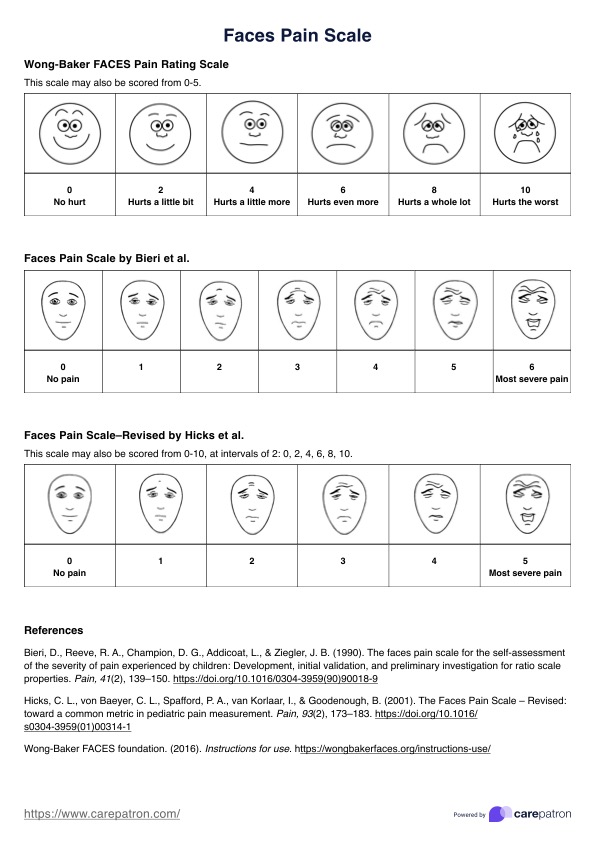
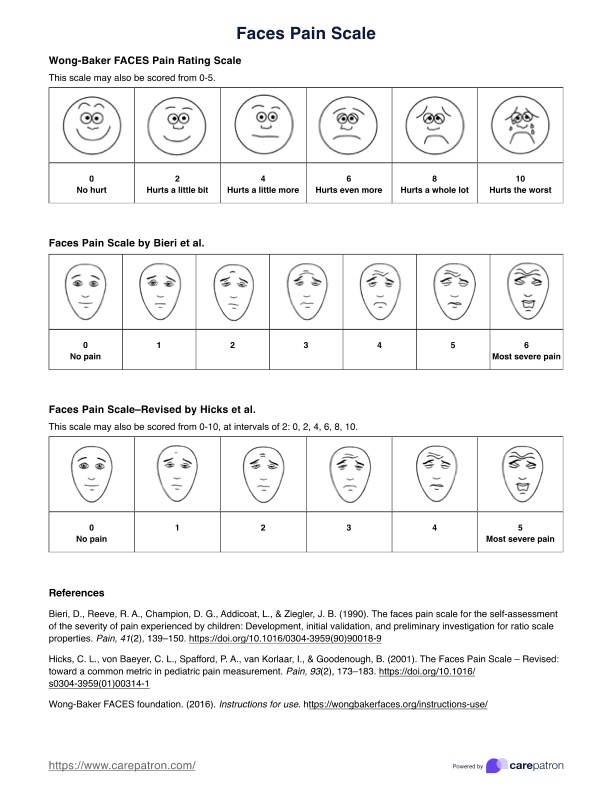

















-template.jpg)


















































































